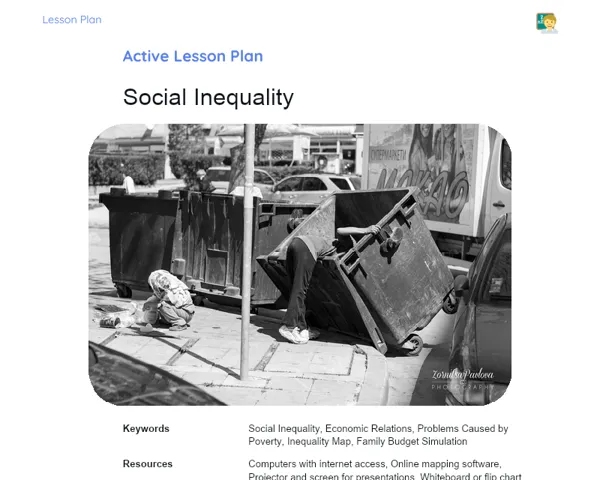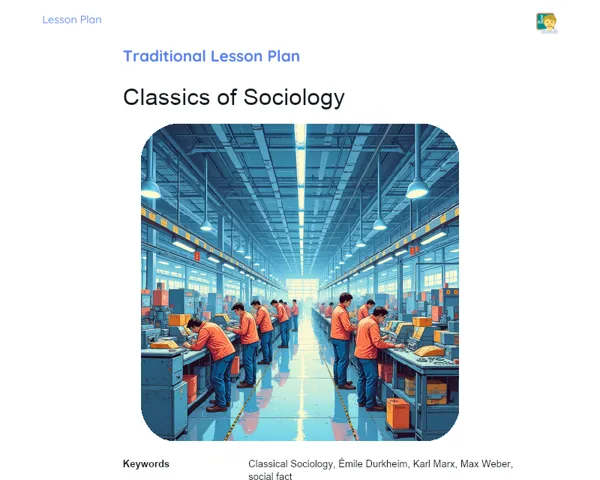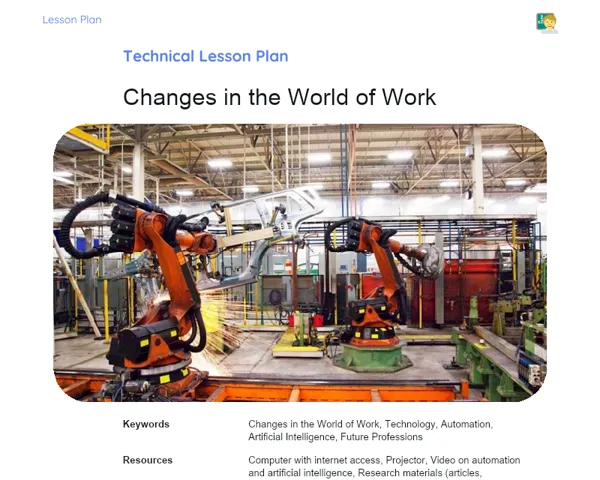Lesson Plan | Socioemotional Learning | Changes in the World of Work
| Keywords | Changes in the World of Work, Sociology, High School, Socioemotional Methodology, Self-Knowledge, Self-Control, Responsible Decision Making, Social Skills, Social Awareness, Technology, Remote Work, Industrial Revolution, Digital Skills, RULER, Emotions, Emotional Regulation |
| Resources | Whiteboard or chalkboard, Markers or chalk, Sheets of paper, Pens, Computer or tablet (optional), Set of questions for debate, Calm environment for meditation, Clock or timer |
| Codes | - |
| Grade | 11th grade |
| Discipline | Sociology |
Objective
Duration: 15 - 20 minutes
The aim of this stage is to provide a clear understanding of the topic at hand, laying a solid foundation for the discussion on the various forms of work and the significant transformations that modern employment presents, particularly with the advent of new technologies. This introductory phase is critical for engaging learners and preparing them emotionally for thoughtful analysis and reflection on the theme, using a socioemotional approach to connect academic content with emotional and social competencies.
Objective Utama
1. Describe the various forms of work throughout history and in today's context.
2. Analyse the shifts in modern work, especially regarding technological tools and their effects.
3. Cultivate the ability to identify and understand the emotions linked to changes in the workplace.
Introduction
Duration: 15 - 20 minutes
Emotional Warmup Activity
Guided Meditation for Focus and Concentration
The chosen emotional warm-up activity is Guided Meditation. Guided meditation is a technique where the teacher leads students in focusing on their breathing to relax their minds and bodies, promoting a sense of calm and concentration that readies them for the lesson ahead. This practice aids in reducing anxiety and enhancing attention and presence.
1. Prepare the environment: Ask students to sit comfortably in their chairs, ensuring their feet are flat on the floor and their hands resting on their knees.
2. Begin the meditation: Instruct them to close their eyes and start focusing on their breathing. Encourage them to breathe deeply through their nose, filling their lungs, and then exhaling slowly through their mouth.
3. Guide the breathing: Prompt the students to maintain this deep and slow breathing pattern while you guide them verbally, saying: 'Inhale deeply... hold for a moment... and exhale slowly...'. Repeat this guidance a few times.
4. Relax the body: Ask the students that with each exhale, they should consciously relax a different part of their body, starting from their feet and moving up to their head. Say: 'As you exhale, feel your feet relax... now your legs... your torso... your arms... your neck... and finally your head.'
5. Positive visualization: After a few minutes, guide the students to envision a calm and safe place where they feel happy and at peace. Encourage them to focus on the vivid details of this setting, such as colours, sounds, and feelings.
6. Closure: Gradually bring the students back to the present, asking them to start wiggling their fingers and toes. Request they open their eyes slowly while still holding onto that sense of calm and focus.
Content Contextualization
The technological revolution has dramatically altered the workplace, introducing new opportunities alongside challenges. For instance, many jobs that were prevalent 20 years ago have been phased out due to machines and software, while new roles like app developers and social media influencers have come into play. These changes elicit varied emotions, including excitement and anxiety, which need to be recognized and effectively managed. Grasping these transformations is vital for adapting and succeeding in today’s job landscape. Additionally, modern technologies provide greater flexibility and efficiency but also demand new skills and attitudes. Remote work, for example, allows individuals to work from virtually anywhere, but it can also lead to feelings of social isolation and difficulty in separating work from home life. Engaging in discussions about these topics helps students develop essential socioemotional skills to navigate these transitions in a balanced and responsible manner.
Development
Duration: 60 - 75 minutes
Theory Guide
Duration: 20 - 25 minutes
1. ### Main Components of Changes in the World of Work
2. Traditional Work Forms: Explain the types of jobs that existed before the technological revolution, such as agriculture, manufacturing, and manual labour. Emphasise how these roles relied heavily on physical skills and less on technology.
3. Industrial Revolution: Discuss the significant transformations instigated by the Industrial Revolution, including mechanisation, urbanisation, and the accelerated growth of factories. Talk about how these shifts impacted society and the job market.
4. Information and Technology Era: Illustrate the changes in employment with the rise of the information age. Explain how the internet, computers, and other digital technologies altered the nature of work, enabling remote work, automation, and the formation of new careers.
5. Remote and Flexible Work: Highlight the importance of remote and flexible options in the current job market. Discuss how the COVID-19 pandemic fast-tracked the adoption of these practices, alongside the benefits and challenges they present.
6. New Skills and Competencies: Stress the necessity for new skills in modern employment, such as digital literacy, critical thinking, and collaboration. Discuss how these skills are increasingly valued by employers and are crucial for career success.
7. Socioemotional Impacts of Changes in Work: Explore the feelings that may surface due to changes in the work environment, like anxiety, stress, excitement, and motivation. Explain the importance of recognising and managing these emotions to maintain well-being and productivity at work.
Activity with Socioemotional Feedback
Duration: 25 - 30 minutes
Group Debate: The Future of Work
Students will be organised into small groups to discuss the changes in the workplace and how they influence their expectations and feelings about their professional futures. Each group will receive a set of questions to facilitate the discussion and will subsequently share their findings with the larger class.
1. Divide the class into groups: Form groups of 4 to 5 students.
2. Distribute the questions: Provide a set of questions for each group to explore. Suggested questions: 'What are the main changes in the work environment that you have noted?', 'How do these changes shape your expectations for the future?', 'What feelings do you experience when thinking about these alterations?'
3. Discussion time: Allow the groups 15 minutes to chat about the questions and jot down their responses.
4. Sharing: After the discussion, each group should select a representative to share their key conclusions with the class.
5. Record conclusions: As the groups present, note the main points on the board to encourage further class discussion.
Discussion and Group Feedback
After sharing the groups' conclusions, the teacher should utilise the RULER method to steer a discussion focused on socioemotional feedback. Recognise: Encourage students to identify and share the emotions they felt during the discussion and while listening to other groups. Understand: Discuss the causes and consequences of these emotions. For example, why do particular changes in the workplace cause anxiety? What are the potential effects of this anxiety on professional performance? Name: Help students correctly label the emotions discussed, such as excitement, fear, anxiety, and hope. Express: Encourage students to express their feelings appropriately, respecting the feelings of others and fostering a supportive atmosphere. Regulate: Provide strategies to manage these emotions, such as breathing techniques, setting realistic goals, and seeking social support.
Conclusion
Duration: 15 - 20 minutes
Reflection and Emotional Regulation
Encourage students to engage in a written reflection or partake in a group discussion about the challenges experienced during the lesson and how they managed their emotions. Questions they can consider include: 'What were the most challenging aspects of the lesson for you?', 'How did you feel during those situations?' and 'What strategies did you apply to cope with those feelings?'. This activity can be done individually or in small groups, depending on the class dynamics.
Objective: The aim of this subsection is to promote self-reflection and emotional regulation, assisting students in identifying effective approaches to handle challenging situations in light of workplace changes. This will help them recognise their emotions, comprehend their causes and implications, and develop the skills to express and regulate those feelings suitably.
Glimpse into the Future
To wrap up the lesson, the teacher can motivate students to set personal and academic goals related to the topics discussed. Have them write down a list of goals they hope to achieve concerning their awareness of changes in the work environment and the enhancement of their socioemotional skills. Goals may include, for instance, 'Learn more about the new technologies used in the job market', 'Enhance teamwork abilities', or 'Practice techniques for emotional regulation'.
Penetapan Objective:
1. Learn more about the new technologies used in the job market.
2. Enhance teamwork abilities.
3. Practice techniques for emotional regulation.
4. Participate in seminars or workshops focused on the future of work.
5. Improve interpersonal communication in a work setting. Objective: The objective of this subsection is to enrich students' autonomy by encouraging them to practically apply their learning. By setting personal and academic targets, students can further their skill development and knowledge, striving for continuity in their academic and personal growth, and better equipping themselves for the challenges and opportunities present in the world of work.



